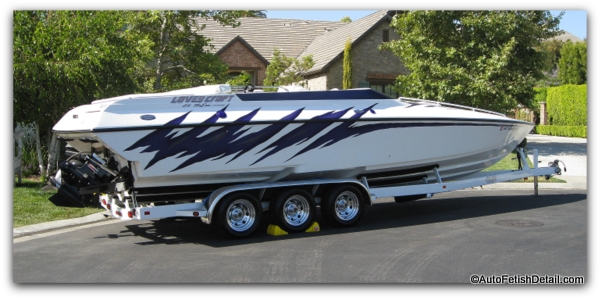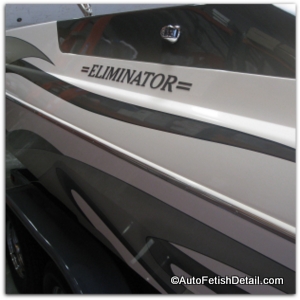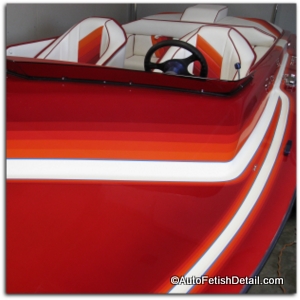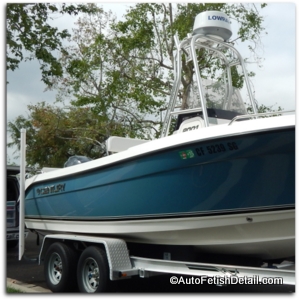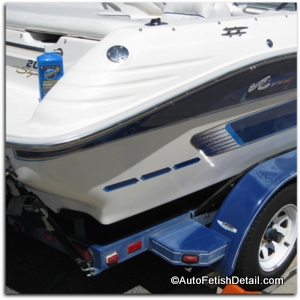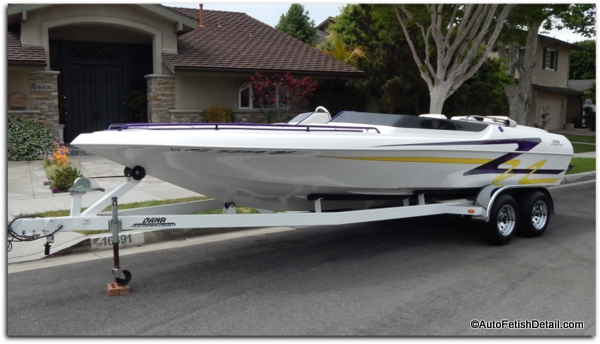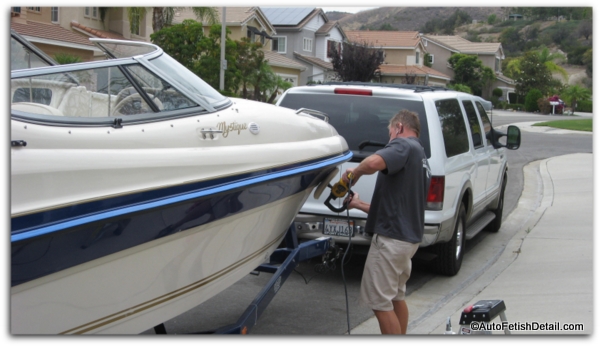Fiberglass Wax
See what the Expert has to teach you!
The truth is, the best fiberglass wax is not really the question most people should be asking.
I accept just as you do that your boat certainly needs protection in the form of a quality boat wax.
Asa a professional detailer with 30+ years of experience I have come to realize how misinformed about their car and the kind of care and maintenance they require.
I have also learned that as a rule, most boat owners know even less as to the real difference in working on their fiberglass boat, what is requires, and understanding that slapping the best fiberglass wax on their boat once a year simply is not going to be enough!
Fiberglass Wax:
To wax or not to wax?
I have come to realize that more bad information than good information exists when it comes to waxing and polishing your boat.
The world of the Internet now makes this worse than ever! We live in what I call the "free information era". A time of history unlike any before where you have more information at the touch of your fingers than you could ever conceivably consume.
And most of this information is misinformation at best, and completely false information at worse.
We are at the point where most of us need to unlearn all the bad information, rather than trying to learn new information.
You and I are on information overload!
We have a situation now where websites written by non-professionals that have no actual industry experience, attempting to teach you about the best fiberglass wax.
These ghost writers simply rephrase and repeat the bad information they collect and learn from the other bad websites written by non-professionals.
It's a problem that is only getting worse as the Internet continues to grow.
Fiberglass Boat Wax:
Bad information, bad labeling
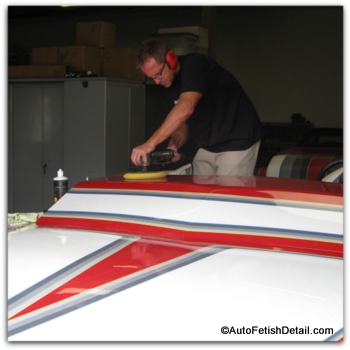
If you thought you were overwhelmed by the bad information taught by non-professionals, add to that the hyped-up labeling of the actual boat wax manufacturers themselves!
Even as an expert myself, speaking form over 30+ years of industry experience, I have a hard time reading through the endless hype and terminology that sounds relevant and significant, but is nothing more than hyped up marketing.
Marketing that is very good at separating you from more of your money.
And all you want is to protect your boat and enhance its appearance. (I know, you actually thought you wanted to find the best fiberglass wax for your boat. The best boat wax is simply a means to the end)
Fiberglass Wax Question and Answers
Q. - Darren, do we really need to wax our boats?
A. Yes. At least if you want to maintain the beauty and value of these toys. Just like car paint, the elements of weather will degrade and "weather" your toys. Every material will degrade as a result of the aging and the weathering process.
Each material needs protection, and choosing the correct or most appropriate form of protection will be required. Choosing the right fiberglass wax and applying on a consistent basis is priority one when it comes to fiberglass and gel coats.
It is a confusing industry regardless of whether you are talking about choosing the best car wax or the best boat wax. Endless choices, endless opinions, endless free opinions all trying to inform, educate, or convince you as to what is the best, what steps to take, and what techniques to use.
I feel your frustration as the care and maintenance of your fiberglass boat is as confusing as it is with your car.
Q. What is the difference between a fiberglass boat and a gelcoat boat? (how are boats made)
A. Nothing. It is simply a difference in labeling versus any actual material or build difference. People simply refer to their boat using different terms.
The reality is that any boat (think of your bathtub or shower enclosure) will be made using both materials and both processes. Yes; there is both the materials and the process.
Fiberglass sheeting (think of cloth material made using fiberglass strands) is simply one of the materials used in the construction of making boats. In most cases, based on quality/cost of the boat, the process is as follows:
- Start with a mold of the boat being manufactured/constructed (the making of a boat mold is an entirely different discussion. We are talking about the making of the boat itself, not the mold used to make the boat)
- Cover the inside of the boat with a carnauba based wax called mold release wax, or simply release wax (Multiple coats of this boat mold release wax must be used to prevent any sticking of the boat construction materials from sticking to the mold. One of the reasons carnauba wax is used in this release wax is that it can be "layered" to produce a truly integral or completeness to this "buffer" layer that allows the other materials to be released without any adhesion problems between the mold and the materials used to construct the boat)
- Most boats are completely white or a solid color for the entire boat (custom boats with graphic patterns, etc., are made differently as the different colors are sprayed or laid down in separate and distinct sequence based on desired appearance of final boat)
- The gel coat material is the first layer to be sprayed into the boat mold (which means it is sprayed onto the mold release wax. the surface of the gel coat being sprayed onto the mold release wax will dry completely, while the exposed side will remain tacky)
- Gel coat is a resin mixed with a hardener (In a simple explanation; this is two liquids that when combined, become hard or non-liquid to created the catalyzed material called gel coat. White is generally the color of choice, but any color can be added to this two-part gel coat process)
- Once the gel coat (two-part resin/hardener) is sprayed into the boat mold, then fiberglass cloth sheeting is hand laid into entire boat mold.
- Once fiberglass cloth is laid out, a second type of resin and hardener is either sprayed or rolled onto fiberglass sheeting
- The fiberglass cloth becomes saturated with this two-part resin/hardener and is then squeegeed out to remove excess resin/hardener before it fully cures into a solid material (excess resin/hardener is unwanted at this stage. Complete saturation of the fiberglass cloth is required, but excess resin/hardener is unwanted)
- Once this has hardened up, or fully cured (fully cured is different than fully cross-linked at the molecular level. This means the gel coat and fiberglass cloth can be stiff or hard enough to remove from the boat mold, but will in fact, continue to catalyze or fully cross-link at the molecular level once it is removed from the mold)
Darren's Note: If you actually took the time to read through that boat making process, you can likely begin to see why people refer to their boats as having gel coat or calling them a fiberglass boat. Which then ripples into the terminology of referring to boat wax as fiberglass wax, versus marine wax, versus car wax, and so on.....
Q. - I have always heard that natural carnauba products are best.
A. First off, the "best" of anything will always depend on the exact benefits you are looking for. When it comes to choosing the best in a fiberglass wax, I am of the opinion that regardless of the actual fiberglass wax you choose, the best boat wax will be the wax that makes it onto your boat more often, not less often.
This has more to do with finding the best rated boat wax, and more about the user experience. Because when it comes down to it, if you are willing to pay any amount of money purchasing the best boat wax based on the endless boat wax reviews written mostly by non-professionals and this new boat wax is so miserable to use, it's never going to make it onto your boat.
If it never makes it onto your boat because of a very poor user experience, than how good is that wax really going to be?
While carnauba wax has long been the accepted king when it comes to car wax or boat wax, I will always default to the wax you are willing to use more often, not less often regardless of what it is made of.
Q. - What is the difference between marine wax and car wax?
A. Nothing. (sorry to inform you of this) I know you will dismiss this as it goes completely counter to what you have been lead to believe, but the same natural wax or synthetic ingredients that car wax products are made with, are also the same ingredients used to make marine grade or boat waxes.( I realize that the labeling on any marine or boat wax will make very compelling claims as to why that particular boat wax or marine wax is truly unique and a requirement for your boat, but it is simply false statements used to sell you more products)
Despite the differences in car paint and fiberglass or gelcoat boats, the ingredients are used for both materials. The manufacturers simply label them differently. It is not necessarily a case of manufacturers lying or misrepresenting to you, they simply accept that as a boat owner you would more easily put your trust and faith into a product that was specifically labeled and marketed to your specific situation and needs.
Which is why you not only could use the best car wax on your boat, but you could also use the best fiberglass wax on your car.
Also noteworthy is the fact that virtually any marine yard or marine service facility will not let any product onto their premises unless it is labeled as a "marine use" product.
Q. - What if my boat already has some level of oxidation to the fiberglass or gel coat?
A. What I can tell you is that virtually every boat is going to have some level of oxidation to it. Most times your boat will still appear to have some shine to it which then leads you to the conclusion that your boat simply needs some form of wax made for fiberglass versus car wax.
The problem is that it takes very little oxidation on your fiberglass boat to change the requirements on your part as to how you approach what you are really trying to do: add shine add protection to your boat through the use of some top rated fiberglass wax.
If your boat is heavily oxidized you will likely be capable of determining this almost immediately with a quick visual examination. But many boats that have oxidation will also still have some level fo shine to them.
And because of this, you will likely conclude that applying a good fiberglass wax is going to suffice; but it won't. Once gelcoat or fiberglass begins to oxidize, it develops a porous layer of dead "material" in the form of dead or dried out fiberglass/gelcoat material.
If you attempt to apply your favorite fiberglass wax or dedicated boat wax to this, you will quickly realize that is becomes an exercise in futility as the wax immediately soaks into this subtle dead layer of oxidation making it almost impossible to successfully wax your boat.
Fiberglass Wax:
What Would Darren Do (WWDD)
So often I get the plea from a passionate follower of mine with a very direct and straightforward request:
"Darren, can you just tell me what you would do?!"
And for this reason I often do just that. Tell people just like yourself exactly what I do professionally and as a person with my own "toys".
I will break the remainder of this page down to (3) specific levels of engagement based on how you have determined the condition of your boat and tell you exactly what I would do. I will tell you what I do professionally, as well as offer an alternative you might find more appealing to you.
Fiberglass Wax:
Boats with ZERO oxidation to them
I realize at this point, trying to figure out if you boat has zero oxidation to it may seem difficult to determine, but the good news is that the Marine wax I am going to suggest will not leave any chalky residue at all!
Unlike traditional paste or liquid marine waxes that haze up and chalk up, this product will not do that.
CSi Marine Wax:
Darren's First Choice
- My "go-to" marine wax that isn't labeled as an actual marine wax (perfect for use on any of your "toys": cars, RV's, boats. watercraft, etc.)
- Never chalks or hazes up like traditional fiberglass wax in paste or liquid versions (this also means that if your boat has any level of oxidation on it and you aren't sure, you don't have to worry about this wax making a big, chalky mess on your boat)
- So easy to use, that I know it will make it onto my boat more often, not less often (thus making it my top rated choice in a fiberglass wax or a boat wax)
- Non-staining formulation that can also be used to "treat" or condition all your boat vinyl seating materials
- Can also be used on any plexiglass windshields of your boat
- Use as often as you are willing (the more the better to prevent the oxidation process that fiberglass boats are notorious for doing)
- Can be use in direct sunlight (this is what is called true waterborne technology which means the water molecule is the carrier for the active/inert ingredients. This water molecule also acts like an insulator thus allowing you to use this marine wax in direct sunlight on hot surfaces)
- Only recently available to the public through Amazon
Meguiar's Flag Ship Marine wax:
Darren's second choice
Meguiar's M6332 Flagship Premium Marine Wax - 32 oz.
- Since this is a liquid marine wax, it will be slightly more time consuming to wax your boat with
- Meguiar's carries a healthy reputation for quality products
- Excellent reviews
- Easy on, easy off (relative to any other liquid or paste marine wax of fiberglass wax)
Fiberglass Wax:
Choosing and using a cleaner wax
Darren's Note: If you are here looking for a fiberglass wax and are attempting to wax your boat then I need to add the following baseline tips:
- Gel coat/fiberglass is not car paint. (your boat may have been painted, but that would be the exception, rather than the rule. I come across very few boats that have literally been painted over the gel coat))
- Gel coat/fiberglass is literally like trying to wax your bathtub. Same material, same process of manufacturing.
- If you are unsure as to how to start or want to practice first, you can literally test in your bathtub/shower if you know it is a fiberglass bathtub or shower enclosure (99% of them are)
- Gel coat/fiberglass oxidizes very differently than 2 stage car paint. Gel coat/fiberglass will become chalky. The tricky part is that even if your boat still has shine to it, in 99% of the cases it will also have some level of oxidation that you will not realize until you try and wax it. For this reason I always recommend that a person start with a cleaner wax like the two below.
- Just because it is a cleaner wax should not alarm you if you are waxing your boat for the first time and you think it is in pristine condition. You will be completely safe in using one of these cleaner waxes.
If you are dealing with mild to moderate levels of fiberglass or gel coat oxidation, then a cleaner wax is effective if you are looking to simplify your world from 2 steps, into 1 step.
Meguiar's M5032 Marine/RV One Step Cleaner Wax, 32 fl oz
- One of my all time favorites!
- Easy to use.
- Ideal for any boat regardless of how perfect you think it is.
- Ideal for anyone unsure as to exactly where to start.
- Can be used as many times as you want if you realize you have more oxidation than you realized until you achieve desired results (or your arm grows tired first of the repeat applications.
3M 09005 Marine Restorer & Wax, 16 oz.
- A trusted name in automotive and marine appearance products.
- Will produce pretty much the same results as the Meguiar's above.
- The choice will be more about which brand you trust most.I am confident in recommending any of the brands on this page based on what you determine is the best "version" of fiberglass wax according to my guidelines I have laid out on this page.
Darren's Tips:
When using any of the products above, I recommend applying with a damp micro-fiber cloth using heavy handed pressure, as you will literally be doing hand polishing. Back and forth or circular strokes is acceptable. Remove using a dry micro-fiber cloth.
Repeat with your applications as many times as necessary to achieve desired results. For many of you, this could literally be more than two applications for each section. You are safe and you will likely be surprised at how much oxidation reveals itself as you begin to work.
The satisfaction is intoxicating as your bring more and more shine to your boat or RV as you work.
P.S. I also know that most of you will be disappointed in the results you get with the above products if your boat has medium to heavy oxidation. For this reason I recommend people like yourself start with a heavy duty compound to remove the oxidation.
I realize most of you will be nervous at the thought of using a heavy duty rubbing compound on your boat. Just know that gelcoat is such a durable material that it would be seriously impossible for you to damage your boat using a rubbing compound like my top choice below: the CSi Rip Cut.
Fiberglass Oxidation Removal:
Why does gelcoat or fiberglass oxidize
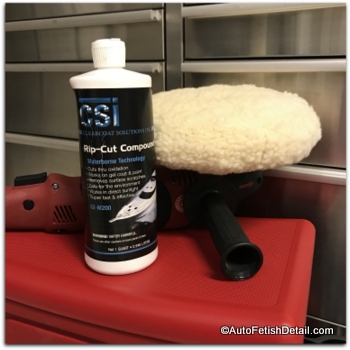
I see many boat owners approach the washing and waxing duties of their boat like they do their cars. The problem is that gelcoat or fiberglass is not car paint.
Gelcoat oxidizes so easily due to the fact that it is a very porous material (it is also very durable, strong, and cheap to use in the construction of boats). Oxidation of any material as a rule is a direct result of the material being exposed to oxygen. Oxygen in the form of the air you and I breathe.
It is called being exposed to the elements. And the elements of oxygen (air) and weather causes this unwanted effect of oxidizing or degrading the gelcoat material.
Car paint is not porous like gelcoat is and therefore does not oxidize like your boat will. This is one of the major reasons car manufacturers started to clear coat cars.
You may have noticed that modern day cars no longer turn chalky or fade like they did 30+ years ago before the introduction of clear coat paint.
Because gelcoat is such a porous material, all these exposed pores will oxidize very quickly f you do not keep a quality fiberglass or marine wax on your boat. This wax fills in all those endless microscopic pores and protects against the elements.
Fiberglass Oxidation Removal:
Heavy duty polishing compound
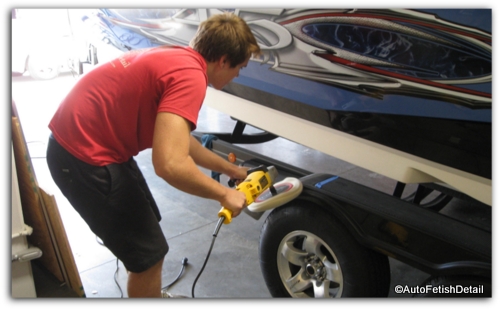 Here my 16 year old son is using the Dewalt high-speed polisher to polish the fender on this boat trailer. It was literally his first time behind a buffer. He is using a Tiger Cut wool pad and the Rip Cut polishing compound
Here my 16 year old son is using the Dewalt high-speed polisher to polish the fender on this boat trailer. It was literally his first time behind a buffer. He is using a Tiger Cut wool pad and the Rip Cut polishing compoundI realize that you came looking for the best fiberglass wax for your boat and now I have taken you into the world of machine polishing and heavy duty polishing compound.
All in the name of trying to remove the oxidation from your fiberglass boat (gelcoat).
I just know how difficult boats can be to wax once they have begun to oxidize. I also know how quickly boats begin to oxidize even though your boat still has some shine to it.
Once you start rubbing on the gelcoat or fiberglass of your boat, what is revealed is very shocking to many a boat owner.
Therefore I am including this section that takes us down the path of fiberglass wax to polishing your boat with a compound.
Fiberglass Machine Polishing
CSI Rip Cut Compound Quart 62-M200-Q
- The ONLY polishing compound I use when working professionally to remove oxidation, scratches, or dull appearance to any gelcoat or fiberglass boat
- Professional grade that is so user friendly that any beginner can also use
- Works in direct sunlight regardless of your working conditions (this means regardless of direct sunlight or hot surface, you can use this product)
- A heavy duty compound that can also finish down to a swirl free finish in most cases by switching from a wool cutting pad to a foam finishing pad
- For use with machine polishing or by hand polishing
- If you have any boat bigger than 21" and plan on polishing out the entire boat, you will most likely need more than one quart, or purchase a gallon size
Wool Cutting Pads
- My "go-to" wool cutting pads
- I love these pads as they are part of the CSi hub-centric ring centering system that allows you to instantly center your pad onto the CSi backing plate below
- I recommend these wool pads for working on boat oxidation removal due to how "strong" gelcoat is (strong gelcoat means strong oxidation which means you're gonna have to be aggressive to produce the results you are after)
- You will need multiple wool pads based on how big your boat is and how much compounding you end up having to do
- I would recommend at least 3 wool pads for any project starting from a 19" boat on up
Backing Plate for machine Polishing
CSI 62-305 Buffing Pad Backing Plate
- This backing plate fits any traditional USA model rotary polisher (not intended for dual-action, random orbital polishers)
- Hub-centric ring system backing plate is ideal for using the CSi Tiger Cut wool pads from above
- This backing plate can be used with any hook-and-loop (Velcro) polishing pads as long as it is a rotary polisher
Fiberglass Wax:
Going from waxing to polishing
If you are looking to take your boat to the highest level, then machine polishing will be the next step. The good news is that due to the latest generation of soft-start polishers, they are ultra safe as you remain in complete control.
DEWALT Buffer/Polisher, Variable Speed, Soft Start, 7-Inch/9-Inch (DWP849X)
- Variable speed polisher with with soft-start (You control the speed at both the trigger and a dial. Soft start trigger means that regardless of how high the dial speed limit is set to, when you pull the trigger, you can ease into it until the polisher speed ramps up to the setting of the dial)
- This polisher can be set to an extra low 600 RPM operating speed. (this is very low. High-speed polishers have such a bad reputation among people who have used them to polish cars, but not only is polishing fiberglass or gelcoat such a different animal, but a 600 RPM sped setting is super low)
- Gel coat/fiberglass is extremely durable and tough. Unlike car paint with much softer clear coat, it would be extremely hard to mess up your boat with one of these "scary" high-speed polishers
- Once you do the heavy lifting of polishing your boat with this polisher and the recommended Rip Cut and wool cutting pads, then you can use the best fiberglass wax of your choosing.
Fiberglass Boat Polishing
The area of boat care is an area filled with much bad information repeated by misinformed or inexperienced people.
I have included the pictures below in the attempt to motivate you in taking that next step from simply applying your favorite fiberglass wax to polishing your boat with a rotary polisher.
The results are impressive in picture, but still don't do the real-world results justice when you see it first hand.
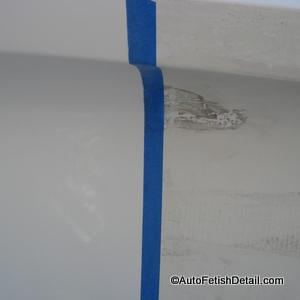 |
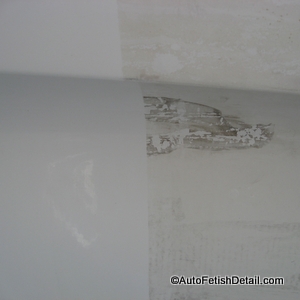 |
Above it an example of some polishing I did on an oxidized boat. I used blue painters tape to create a before and after effect. Not only is the boat gelcoat oxidized, but the side of the hull had some serious scuff marks that I also polished out.
The second picture is the same area after I removed the blue painters tape so the true before and after results could be seen.
These are the type of results only capable with using a rotary polisher, wool cutting pads, and the Rip Cut compound.
 Using the Dewalt high-speed polisher to remove heavy layers of oxidation from the fiberglass hull before I apply some of the "best" fiberglass wax.
Using the Dewalt high-speed polisher to remove heavy layers of oxidation from the fiberglass hull before I apply some of the "best" fiberglass wax.The Bad News:
Because gel coat and fiberglass is such a durable and tough material, when it comes to polishing and removing oxidation, it requires more product and more work. The heat and friction required to remove heavy layers of oxidation are only possible through the use of a high speed polisher and wool pads.
Yes you can attempt to do this by hand, but it will prove an extremely frustrating experience and when compared to the results you can produce by machine, there simply is no comparison.
The Good News:
The good news of this is that polishing on these tough and durable materials of fiberglass and gel coats means they are also much more forgiving when it comes to the possibility of damage during use of the high speed polisher. So if you are a beginner, and have been sitting on the fence as to whether or not you want learn how to use a high speed polisher, it would be next to impossible to do any form of actual damage. The great thing about the latest in rotary polishers (high-sped buffers) are the ability to dial them down to such a low operating speed of only 600 RPM's.
Fiberglass Wax Conclusion
Interesting how many topics that appear simple at first, but can become rather complex subjects very quickly.
Our discussion on fiberglass wax is no exception. I hope through our discussion on selecting a fiberglass wax has left you both informed and empowered to make an informed decision!
I wish you much success!
Sincerely,
Darren Priest
|
|
